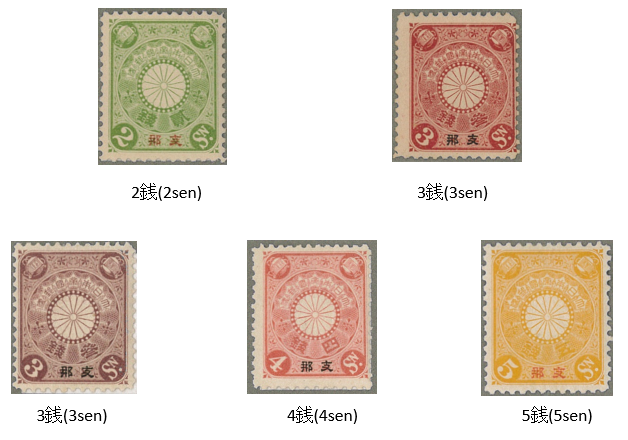
支那字入菊切手 2 1900(明治33年)8月 発行 1895年(明治28)に日本は日清戦争に勝利した。日本は、その後も中国本土に軍を駐留させ、民間人による現地経済活動を促進させた。1899年(明治32)11月、逓信省令により、1900年 1月から在韓国及び在支那(中国)で売り捌かれる切手は、「朝鮮」または「支那」の加刷をする こととなった。その理由は、当時、朝鮮や支那の通貨は日本円に比べ実勢レートが20%程度低かったため、現地通貨で日本切手を買い、日本国内郵便局で買戻し請求する差益獲得事例が出てきたため、その防止策として加刷切手の発行が行われた。従って、これらの加刷切手は、日本国内では使用できなかった。朝鮮字加刷切手は1901年に廃止されたが、支那字加刷切手は、日露戦争勝利により満州南部の実質支配が行われた後も、中国での日本通貨の流通網達成が相当期間に渡り困難だったため、1922年(大正11)まで使用された。
China overprint ・Chrysanthemum Series 2 Issued on August 1900 (Meiji33) In 1895 (Meiji 28), Japan won the Sino-Japanese War. Japan continued to station troops in mainland China to promote civilian local economic activity. In November 1899 (Meiji 32), by the Ordinance of the Ministry of Communications, stamps sold in Korea and China from January 1900 will be overprinted with "Korea" or "China". The reason is that at that time, the prevailing rate of Korean and Chinese currencies was about 20% lower than that of Japanese yen, so there were cases where Japanese stamps were bought in the local currency and repurchased at the Japanese post office. As a preventive measure, reprint stamps were issued. Therefore, these overprint stamps could not be used in Japan. Korean overprint stamps were abolished in 1901, but Chinese overprint stamps have been able to achieve the Japanese currency distribution network in China for a considerable period of time even after the real control of southern Manchuria was achieved by the victory of the Russo- Japanese War. It was used until 1922 (Taisho 11) because it was difficult to reach.
